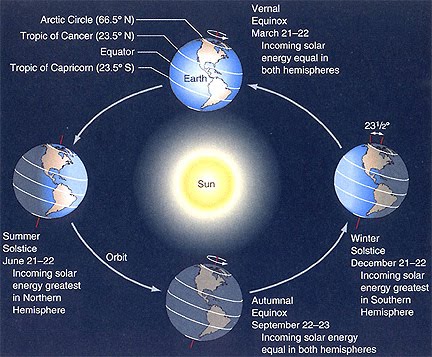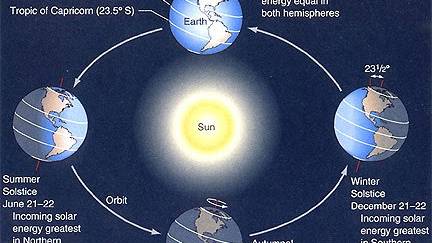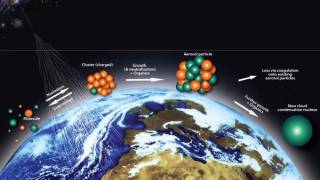Cosmic changes? Participate in simple Solstice experiment!

Earlier this year the sun returned back from the polar night too early in several places within the Arctic Circle. Was this due to an orbital disturbance in the solar system? You can contribute in finding out! Help out by making an easy field experiment proving if this might be the case. It only requires measuring the length of the shadow at noon in the days around the summer solstice. But you must act now! Let us first look at some background information:
It was reported in some news media that the first sunrise of the year came too early in Iluissat, of western Greenland. At this place the three-and-a-half month long polar night is supposed to end on January 13th, as far back as living memory goes. But this year this much longed for event was reported as occurring already around 1 pm on the 11th of January - about 48 hours early. [1]
Mainstream media circulated global warming as the explanation for this, as melting polar ices was thought to lower the horizon. [2]
However, an extensive amount of data shows that no global warming has taken place since the late 1990s; and that the mean volume of the polar ice caps is not decreasing. This view is held by a large number of top climate experts. [3]
This phenomenon was called an "isolated event"; and according to John Walsh, professor of atmospheric science at the University of Alaska Fairbanks, such a change in the true sunrise is impossible "because that would require the Earth-Sun orbital parameters to change". [4]
But what if the orbital patterns actually have changed? And what if it was not an isolated event? Various places reported a similar solar anomaly; which also discounts the "melting ice" explanation. In Barrow, Alaska, the sun rose a week prior to the estimated time. This was labelled a "false sunrise" as it was thought to be a mirage. [5]
This may very well be a mirage; however, in Norway a local newspaper reported that the solar return appeared one day ahead of its scheduled time. [6]
Also in Finland the end of the polar night was observed too early. According to a Finnish newspaper it rose days too early in Utsjoki (how days many was not stated). [7]
Just a week prior to these anomalies it was also reported that Tampa airport in Florida, US, had to close the airport for a week in order to readjust its runways due to a shift of the North Magnetic Pole. [8]
The same week as the premature end of the polar night a report by the Star Tribune, Minnesota US, created much fuzz in the news about a shift in the zodiac. According to astronomer Parke Kunkle the astrological signs were off by an entire month. [9]
It is well known that the phenomenon of the roughly 26,000 year cycle of the precession of the equinoxes causes such a shift; however, this change in the obliquity of the ecliptic is a very slow process. This means that the angle of inclination between equator and the plane of rotation around the sun, currently about 23.45 degrees, will change with only 1 degree every 72 years. [10]
But if it was the slow process of precession that was responsible for this shift why was it not noticed earlier on? Why did this discovery come like a surprise? And why the sudden call for a new zodiacal calendar? Since these anomalous phenomena all appear at the same time we must ask ourselves if they are related; and if they could be due to a change in the orbits of the solar system. To find out if this actually is the case an ancient method may be used, using the phenomenon of the solstices. If you are are located in the northern hemisphere, north of the Tropic of Cancer (23°26’N), you may easily conduct your own field experiment. Here, the sun reaches its highest position in the sky of the year on the summer solstice, which happens on June 21st. [11]
This date is the longest day of the year, and the sun therefore will cast the shortest shadow of the year at solar noon. [12]
Don’t miss this opportunity to help find out if we are in a period of orbital changes in the solar system. Such an experiment is very simple, for example:
1, Choose or make a vertical pole of some sort, to be used to cast a shadow. It should be steady and thoroughly fixed, so no change will occur in its height or angle. The ground should be flat so it is easy to measure the shadow.
2, Measure and mark the length of the shadow at 12.00 local time each day. Make sure your watch is absolutely correct and that your measurements are made at this exact time.
3, Document and compare the length of the shadows.
But most importantly: do it now!
You should make this as many days ahead of the summer solstice as possible, so you have lots of data to compare with. One or two days ahead is not enough, and the 21st is here very soon! This may be an important opportunity that is not to missed, and the more people gathering such data the more difficult it is to dismiss it - should it prove anomalous. Then you may send in the material to Red Ice Creations so it all gets collected in one place. If the shortest shadow is not observed on the 21st of June it may indicate that the celestial motions are disturbed - which may be very important to know. We can not count on the mainstream media to inform us if we are in a period of cosmic changes - we must assume that responsibility ourselves. This is your opportunity to make that contribution.
- Nicolas Rodriguez
Send your results to redicecreations@gmail.com , subject: Solstice.
Sources:
1.
The sun rises two days early in Greenland, sparking fears that climate change is accelerating
Daily Mail, 14 January 2011
http://www.dailymail.co.uk/sciencetech/article-1346936/The-sun-rises-
days-early-Greenland-sparking-fears-climate-change-accelerating.html
2.
Greenland’s race for minerals threatens culture on the edge of existence
Stephen Pax Leonard
The Observer, 6 February 2011
http://www.guardian.co.uk/world/2011/feb/06/greenland-inughuit-
mineral-mining
3.
The Great Global Warming Swindle (documentary film)
Martin Durkin, 2007
http://video.google.com/videoplay?docid=-5576670191369613647#
Global Warming: Doomsday Called Off (documentary film)
Canadian Broadcasting Corporation, 2005
http://video.google.com/videoplay?docid=-3309910462407994295#
4.
Strange Claim: The Sun Rose Two 2 days Early in Greenland
Wynne Parry
Live Science, 17 January 2011
http://www.livescience.com/10417-strange-claim-sun-rose-2-days-
early-greenland.html
5.
’False sunrise’ whets expectations for sun’s reappearance in Barrow
Alex DeMarban
Alaska Newspapers, 21 January 2011
http://www.alaskanewspapers.com/article.php?article=1103false_sunrise_
whets_expectations_for_suns
6.
Solas snikpremiere
Michael Jørn Hagen
iTromsø, 20 January 2011
http://www.itromso.no/nyheter/article423177.ece
7.
Kaamos päättyi etuajassa Utsjoell
Lapin Kansa, 16 January 2011
http://www.lapinkansa.fi/cs/Satellite/Lappi/1194662390117/artikkeli/
kaamos+paattyi+etuajassa+utsjoella.html
8.
Magnetic North Pole Shifts, Forces Runway Closures at Florida Airport
Jeremy A. Kaplan
Fox News, 6 January 2011
http://www.foxnews.com/scitech/2011/01/06/magnetic-north-pole-
shifts-forces-closure-florida-airport/
9.
Sign of the times: Astrology story soars like a comet
Star Tribune, 14 January 2011
http://www.startribune.com/lifestyle/style/113100139.html
10.
Axial precession (astronomy)
Wikipedia
http://en.wikipedia.org/wiki/Axial_precession_(astronomy)
11.
Summer solstice
Wikipedia
http://en.wikipedia.org/wiki/Summer_solstice
12.
Astronomy: the evolving universe, p 8-11
Michael Zeilik, 2002






















